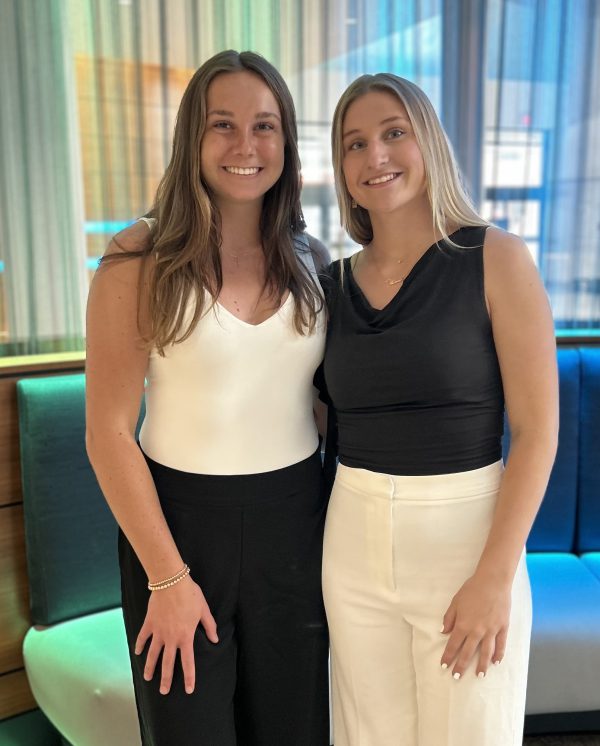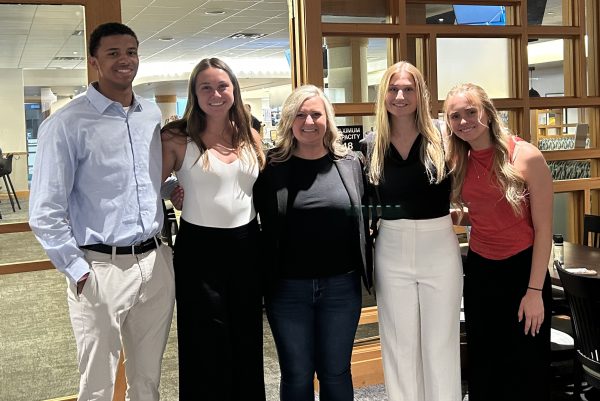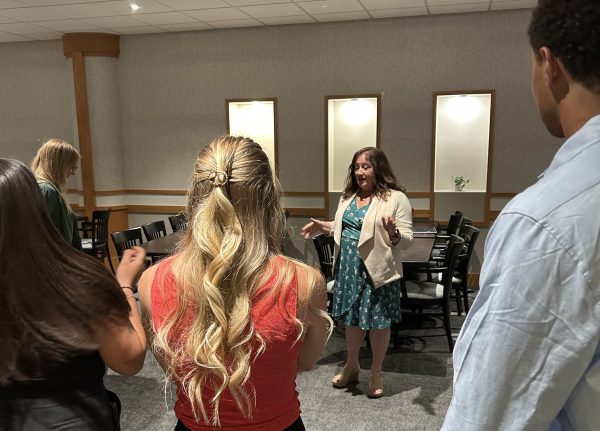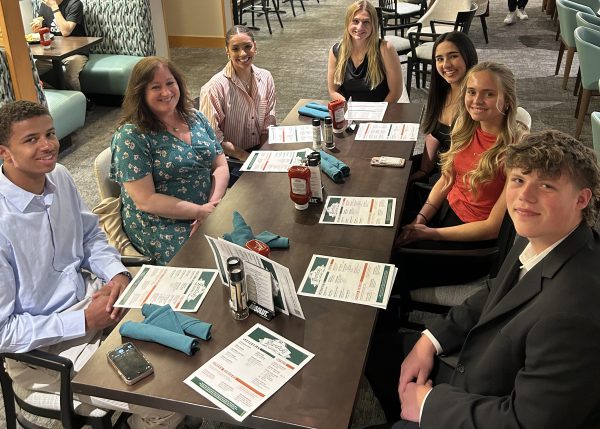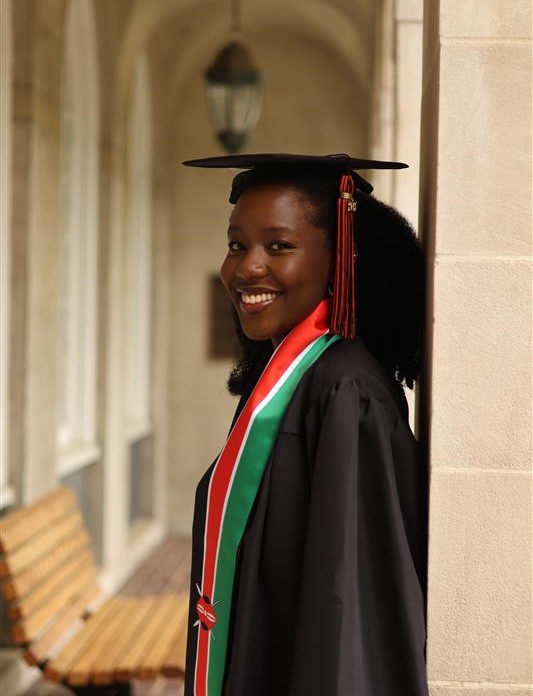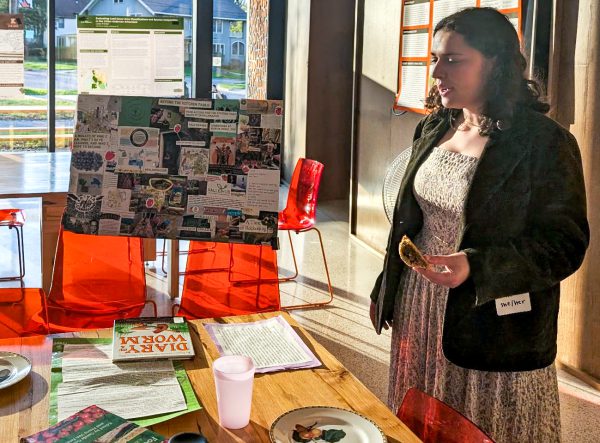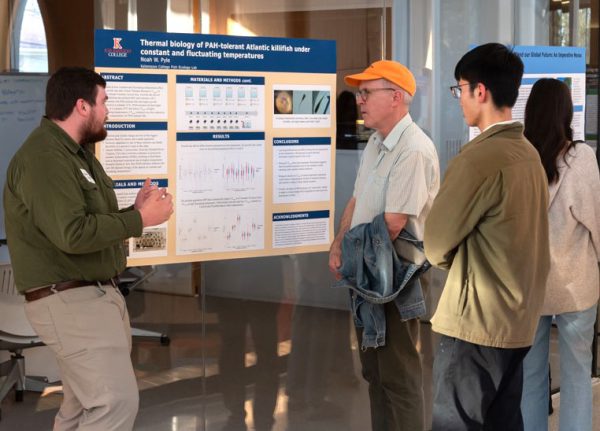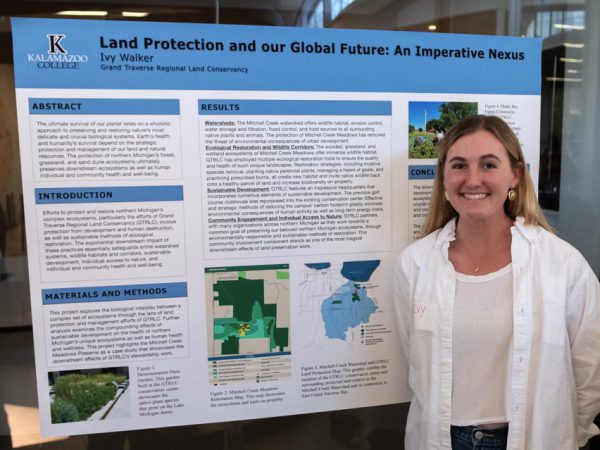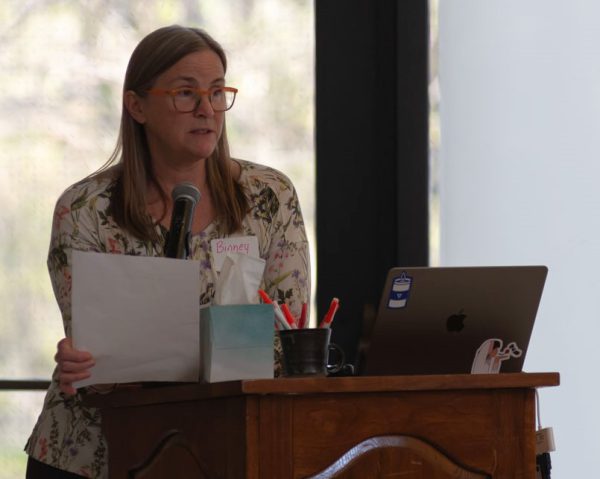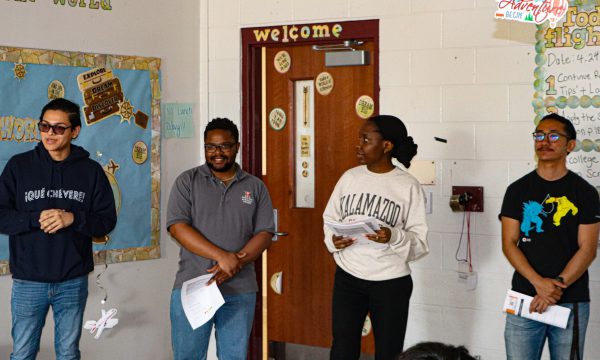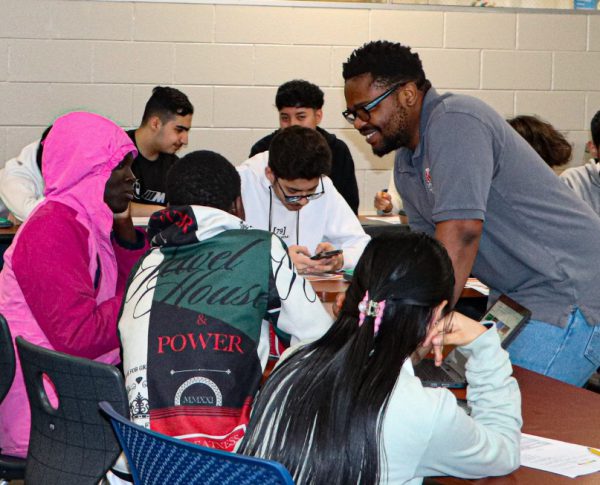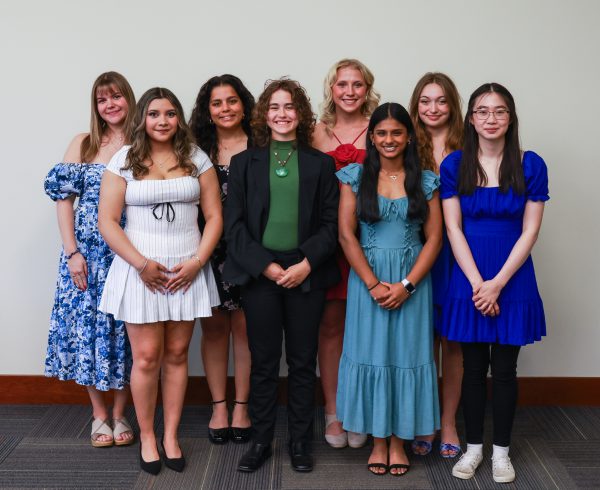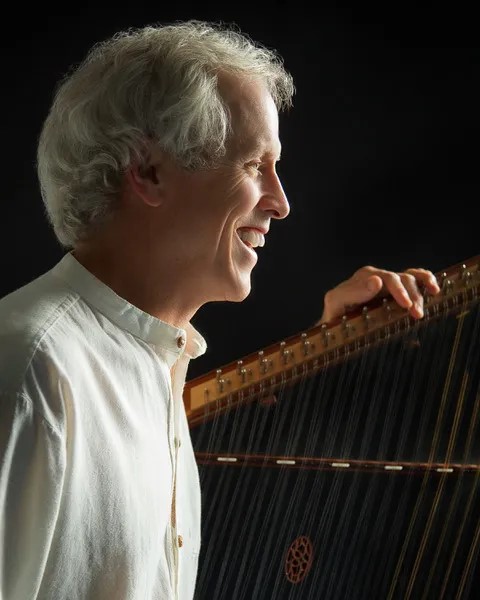Congratulations to the following Kalamazoo College students who achieved a grade point average of 3.5 or better for a full-time course load of at least three units, without failing or withdrawing from any course, during the Spring 2025 academic term.
Students who elect to take a letter-graded course on a credit/no credit basis (CR/NC) are not eligible for Dean’s List consideration during that term. Nor are students who receive an F, NC or W grade for that particular term. Students with incomplete (I) or in-progress (IP) grades will be considered for the Spring 2025 Dean’s List upon receipt of their final grades.
Dean’s List recognition is posted on students’ transcripts. Kudos to the entire group for Spring 2025.
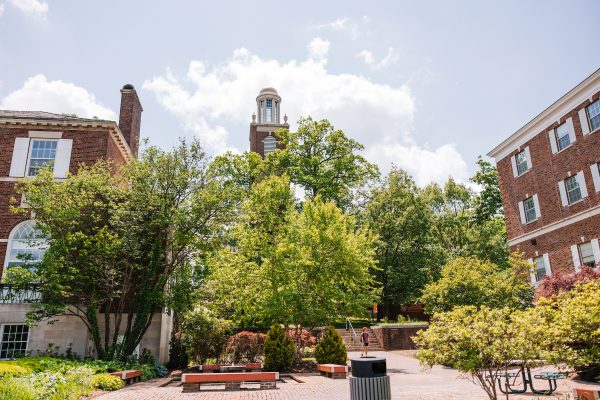
Spring 2025
A
Callie Abair
Kyle Ackerson
Aliyah Adams
Tahmina Ahadi
Fuzail Ahmed
Isabella Alimenti
Zoe Allen
Randa Alnaas
Mahmoud Alsafadi
Emiliano Alvarado Rescala
Zahra Amini
Haresh Anand
Antonio Angeles Roque
Michael Ankley
Madison Anspach
Ava Apolo
Eva Applebaum
Elizabeth Aquino Lopez
Maya Arau
Jeremy Ardshahi
Peyton Arendsen
Emerson Arensman
Louis Asmus
Leonie Assier
Emily Auchter
James Azim
B
Gabrielle Baldori
Baylor Baldwin
Johanna Balingit
Poppy Balkema
Leila Bank
Grace Barber
Evan Barker
Brianna Barnes
Luke Barnum
Lena Barrett
Gabriella Barry
Joseph Basil
Benjamin Battreall
Alyse Baughman
Sekai Beard
Emma Becker
Annabel Bee
Josephine Belsky
Cassandra Bennett
Aubrey Benson
Jane Bentley
Thomas Bentley
Julian Bilbao
Josephine Bischoff
Henry Black
Derek Blackwell
Cara Boissoneault
Mathys Bordeau
Jack Boshoven
Juliette Bournay
Yvette Boyse-Peacor
Jay Breck
Teige Bredin
Georgia Brennaman
John Brewer
Anakah Brice
Chloe Briggs
Jacquelyn Brines
Ellie Britt
Avery Brockington
Blair Brouwers
Chloe Brown
Ava Buccafurri
Anna Buck
Jaden Buist
Christopher Bullard
Leah Bunnell
Sara Bush
Ava Butera
Tavi Butki
Zachary Butters
C
Erendira Cabrera
Amaia Cadenas
Evelyn Calderon
Bailey Callaway
Kennedy Campbell
Eleanor Campion
Grace Cancro
Olivia Cannizzaro
Raymond Cargill
Meredith Carstensen
Joe Caton
Christopher Cayton
Abigail Caza
Haziel Cerroblanco
Bo Chambers
Derrick Chen
Noah Chun
Yaire Cisneros Tovar
Eva Clancy
Alisha Clark
Lourdie Clark
Maya Clarren
Lilly Cleland
John Clements
Brendan Clinard
Louise Colin Sloman
Logan Coller
Toby Comensoli
Isabela Cordeiro
Courtney Cotter
Cate Cotter
Cameron Couch
Holden Coulter
Hannah Crawford
Gavin Crawley
Connor Creech
Cameron Crosby
August Crothers
Lilian Crowder Smith
Gwendolyn Crowder Smith
Skye Crowell
Chase Cummins
Claire Curry
D
James Dailey
Avery Davis
Griffin Davis
Jacob Davis
Jasmine Davis
Asha Dawson
Tara Dean-Hall
Lillian Deer
Noel DeFeyter
Carson Deines
Enrique Delzer
Ethan DeNeen
Maansi Deswal
Jack Dewey
Devi DeYoung
Alexander Di Dio
Martha Diaz Chavez
Michaela Dillbeck
Taylor Dinda-Albright
Alexia Dowell
Charles Doyle
Jordan Doyle
Simon Doyle
Jack Duggins
E
Sally Eggleston
Abigail Eilertson
Rebecca Elias
Evelyn Ellerbrock
Adaora Emenyonu
Francis Ernzen
Dilynn Everitt
Bradley Eziuka
F
Niklas Fagerman
Claire Farhi
Madalyn Farrey
Max Feliks
Peggy Ferris
Sara Finks
Alex Fleming
Sofia Fleming
Mathias Florian
Ross Fooy
Jessica Forbis
Drew Fortino
Kinga Fraczkiewicz
Caroline Francis
Emma Frederiksen
Matthew Freels
Landrie Fridsma
G
Jocelyn Galaviz-Ruiz
Anne Galin
Ethan Galler
Yamilet Garcia
Ingrid Gardner
Roberta Gatti
Lyrica Gee
William Geiger
Mallory Gentry
Grace Getachew
Maira Ghaffar
Nora Ghazal
Logan Gillis
Abigail Gilmore
Nathan Gleason
Makala Goddard
Laura Goia
Maxwell Goldner
Brizza Gonzalez
Charles Gordon
Lukas Graff
Lillian Grelak
Kaitlyn Grice
Cole Grupenhoff
Sarah Guerrero Gorostieta
Kendra Guitar
Oliver Gutierrez
H
Marissa Haas
Aiden Habboub
Andrew Habel
Sydney Hagaman
Isabelle Hahn
Carter Haley
Austin Hamilton
Blu Haney
Alison Hankins
Geneva Hannibal
Colten Hansen
Luke Hanson
Madeline Hanulcik
Rachel Harman
Doyle Harrison
Sophie Hartl
James Hauke
Pauline Hawkes
Tanner Hawkins
Beatrice Hawkins
Willow Hayner
Davis Henderson
Elizabeth Henderson
Megan Herbst
Litzy Hernandez
Felix Hernandez Santiago
Gerardo Herrera-Sanchez
Maya Hester
Ella Heystek
Ashlen Hill
Alyssa Hinkley
Ruby Hogan
Annika Hokanson
Madeline Hollander
Ronin Honda
Joseph Horsfield
Charles Horvath
Tyler Houle
Gavin Houtkooper
Jakob Hubert
Ethan Huebsch
Alek Hultberg
Megan Hybels
Kennedy Hynde
I
Emiliano Ibarra
Carson Ihrke
Britt Inman
Weslee Innes
J
Teddy Jacobson
Nolan Jannenga
Rex Jasper
Ryleigh Jaworski
Morgan Jenkins
Amelia Johnson
Anne Catherine Johnson
Caroline Johnson
Clo Johnson
Johe Newton Johnson
Luke Johnson-Sears
Hayden Johnston
Zane Jones
Ayako Jurgle
K
Amalia Kaerezi
Kiana Kanegawa
Jessica Kaplan
Judah Karesh
Eliza Karlin
Thomas Kartes
Isabelle Kastel
Jackson Keefer
Austin Keur
Mphumelelo Khaba
Vivian Kim
Dong Eun Kim
Si Yun Kimball
Anwen King
Ava King
Samuel King
Claire Kischer
Kathryn Klahorst
Zoe Klowden
Kassandra Koehler
Antoine Kondracki
Cole Koryto
Toni Koshmider
Katya Koublitsky
Marissa Kovac
Julia Kozal
Carrie Kozlowski
Katherine Kraemer
Daryn Krause
Jason Krawczyk
Jack Kreckman
Loden Krueger
Shay Kruse
Annabelle Krygier
Clayton Kryszak
Laryn Kuchta
L
Andrew La Penna
Kathleen La Prad
Nicholas LaFramboise
Rylee Lambert
Jordon Larco
Olivia Laser
Annmarie Lawrence
Madeleine Lawson
Elijah Layne
Son Le Dinh Truong
Miranda Lebednick
Jonah Lederman
Maya Lee
Ellie Lepley
Sage Lewis
Aidan Liedeke
Luis Lizardo-Rodriguez
Alex Lloyd
Katelyn Long
Alondra Lopez
Maya Lopez
Mairead Lynch
Addison Lyons
M
Ellie MacE
Kyler Maiorana
Natalie Maki
Larson Makie
Pauline Makie
William Martel
Isabel Martin
Jesus Martinez
Stephanie Martinez
Natalie Martinez
Cassidy Martini-Zeller
Isabelle Mason
Alexandria Mason
Hollis Masterson
Matthew Matuza
Eliza Maurer
Cedric May
Jay McDaniel
Mollie McDonald
Liam McElroy
Megan McGarry
Leo McGreevy
MacKale McGuire
Jacob McKinney
Amy McNutt
Raven Medina
Gina Mehling
Isaac Melton
Jacey Merkle
Estelle Metz
Gabriel Meyers
Bernice Mike
Ella Miller
Gloria Mireles
Marin Miroslavich
Jackson Mitchell
Carsen Moat
Aliah Mohmand
Raven Montagna
Stephanie Moranko
Eliana Moreno
Elizabeth Morgan
Meena Moritz
Wyatt Mortensen
Maren Mosher
Madeline Moss
Karis Mulcahy
Claire Mullins
Andrew Munger
Ella Myers
N
Alex Nam
Nailia Narynbek Kyzy
Sebastian Nelson
Chloe Nelund
Lily Nestich
Robert Newland
Kevin Nguyen
Yen Giang Nguyen
Theodore Niemann
Savannah Norman
Will Norwood
Thaddeus Nowak
Alex Nutt
O
Nora Oleary
Gabriel Olivier
Emma Olson
Kevin Oneill
B Osborne
Aryka Ostroski
P
Chelsea Paddock
Renzo Palomino Caceres
Brennan Pannucci
Grace Park
Eleanor Parks-Church
Quinn Parpart
Hannah Parsons
Maya Pasillas
Juniper Pasternak
Logan Pearson
Mia Pellegrini
Kaden Peot
Patrick Perez
Addison Peter
Katarina Peters
Noah Peters
Tobias Peters
Paige Peterson
Indigo Philippe
Anna Phyo
Mia Pierce
Timothy Pinches
Corey Pleasant
Elaine Pollard
Evan Pollens-Voigt
Mario Pomorski
Madelyn Portenga
Tadeusz Potocki
Quinten Powers
Q
Alex Quesada
Brody Quinn
Matthew Quirk
R
Elizabeth Rachiele
Akaash Raghunath
Jennifer Rairigh
Alyson Ramillano
America Ramirez
Jazmin Ramos
Cory Rapp
Sadye Rasmussen
Ella Recknagel
Julia Reisor
Isabel Reyes
Micahaia Reynolds
Claire Rhames
Cody Rigley
Sheldon Riley
Emory Roberts
Narelle Robles
Dillon Rodriguez
Nevaeh Rodriguez-Vergel
Schareene Romero Rivera
Olivia Roncone
Brigid Roth
Charlotte Ruiter
Wyatt Ruppenthal
Elliot Russell
McKenna Ryan-Elbert
Olive Ryder
S
Amelie Sack
Zenaida Sackett
Oliver Sajan
Greta Salamun
Abigail Samson
Ryan Sanborn
Alejandro Santiago Roman
Leslie Santos
Simon Sawyer
Fiona Schaffer
Owen Schihl
Leo Schinker
Olivia Schleede
Sophia Schlotterer
Harper Schrader
Cyanne Schuitema
Arden Schultz
Audrey Schulz
Ava Schwachter
Sophia Schwartz
Aurora Scott
Alison Settles
William Seymour
Katherene Shank
Isabella Shapiro
Darby Shawhan
Travis Shemwell
Eric Sheppard
Veda Shukla
Joseph Shumunov
Clara Siefke
Mo Silcott
Julia Sitz
Kiersten Sjogren
Meganne Skoug
Kendall Slamka
Maja Smith
Grace Snyder
Anoushka Soares
Jonah Spates
Ella Spooner
Sophia Sprick
Florian Stackow
Adam Stapleton
David Stechow
Joseph Stein
Katelyn Steinbrecher
Eleanor Stevenson
Joseph Stevenson
Meredith Steward
Jacquelyn Stoddard
Pavel Stojanovski
Elena Stolberg
Liliana Stout
Helen Stoy
Zachary Strauss
Donovan Streeter
Eller Studinger
Abbygale Stump
Katherine Suarez
Senchen Subba
Maeve Sullivan
Hannah Summerfield
Jocelyn Suranyi
Ryan Swarthout
Grace Sweet
Zachary Sykes
T
Chau Ta
Ella Talaski
Jeremy Tarn
Charlotte Tatara
Jovanay Taylor
Levi Thomas
William Thomas
Lucia Thomas-Colwell
Minh Thu Le
Elizabeth Tiesworth
Emily Tiihonen
William Tocco
Lily Toohey
Luke Torres
Phoebe Tozer
Samuel Tremaglio
Vincent Tremonti
May Tun
U
Hannah Ulanoski
Christopher Ulrich
Gabrielle Unger-Branson
Tristan Uphoff
V
Tony Vaisanen
Anthony Valade
Eli Van Drie
David Van Hooser
Gavin Van Kampen
Isaac Vandecar
Lucy Vandemark
Lauren Vanderstelt
Tyler Vanderzanden
Mitchel VanGalder
Ella VarnHagen
Anna Veselenak
Madison Vrba
W
Seth Wanner
Natalie Ward
Annslee Ware
Ryan Warezak
Whitney Warmsby
Nina Warrow
McKenna Wasmer
Jadon Weber
Charlie Weisser
Jordan Wesaw
Emerson Wesselhoff
Carissa West
Kiersten West
Charles Wester
Grace Westerhuis
August Westphal
Benjamin Whitsett
Jay Wholihan
Alicia Wilgoren
Ava Williams
Jackson Willits
Gretchen Wilson
Ruth Wilson
Siona Wilson
Zoe Wilson
Ruby Winer
Alexander Winter
Sierra Winter
Andrew Wolford
Alexa Wonacott
Reagan Woods
Maximilian Wright
Darius Wright
Emma Wrobleski
Y
Hailey Yoder
Z
Kathryn Zabaldo
Nora Zemlick
Katalina Zhao
Maggie Zhu
Brock Zimmerman
Kenzi Zimmerman-Frost
Florian Ziolkowski
Lee Zwart

